Managing Wildlife Populations
Columbian White-tailed Deer Recruitment Surveys: Biologists Stephens, Holman, and Aubrey conducted five surveys for Columbian white-tailed deer on Puget Island from mid-November to the end of December. The purpose of the survey is to get a ratio of does to fawns on the island. As an additional metric, biologists also get a minimum count of deer on the island. Puget Island is one of several areas surveyed for Columbian white-tailed deer during this time frame. This survey effort is coordinated by the U. S. Fish and Wildlife Service and additional participants include Oregon Department of Fish and Wildlife, the Cowlitz Tribe, and volunteers. Biologists counted a high of 189 deer on Puget Island and an average of 46 fawns per 100 does. See graphs below to see how this compares with prior year’s surveys.


Year-Round Bat Acoustic Monitor Installation: Biologists Wickhem and Bergh were joined by Bat Biologist Tobin and Friends of the Columbia River Gorge Stewardship Manager Woods to install a year-round bat acoustic monitoring station on private land in Skamania County. The detector is powered by a solar panel, will only need to be serviced four times per year, and will hopefully be deployed in the same location for at least five years.
Washington Department of Fish and Wildlife and other partners have additional stations set up across the state in an effort to learn more about our native bats. We have many gaps in knowledge for many bat species including simple life cycle and life history. Acoustic monitoring is one way to help begin to answer some of those questions. For example, we can use these data to look at potential migration patterns and routes, seasonal movements, and active periods. These data can help inform wind energy development or elucidate fall and winter activity patterns. We can also use acoustic recordings as an index of activity to detect changes overtime on the landscape. They can also help us understand which species are susceptible to white-nose syndrome.
Acoustic activity has been shown to mirror changes in white-nosed syndrome affected populations, so this is one metric we use to understand impacts from this disease in the absence of being able to assess hibernacula. Visit our website for more information on Washingtons bats and the threat from white-nose syndrome.

Injured Merlin: Biologists Wickhem and Bergh responded to reports of an injured raptor along a private road in Dallesport. When the pair arrived, they found a small merlin hopping next to the road, unable to fly more than a few feet. Thanks to help from two staff members on site, they were able to catch the bird without incident and transport it to Rowena Wildlife Rehab Center. Upon initial exam and x-ray, the veterinarian reported that the female raptor didn’t have any fractures or obvious bruising and was potentially just sore and disoriented after being hit by a car. She appeared to make a full recovery and was released near where she was captured a week later. This was one of three injured bird calls received by District 9 staff members on the same day. Big thanks to Wildlife Conflict Specialist Aubrey and staff members at The Dalles Dam for responding to the other reports.


Dusky Canada Goose Surveys: Biologist Wickhem conducted two dusky Canada goose surveys on the Shillapoo Wildlife Area and surrounding lowlands of Clark County this month. Biologists Stephens and Holman conducted the twice-monthly surveys in Cowltiz and Wahkiakum counties. Dusky geese are a sub-species of Canada goose that spend summers in Alaska and migrate through and/or overwinter in the lower Columbia River. Duskys are closed to recreational harvest due to low population levels.
The purpose of these surveys is to count dusky geese observed and read alphanumeric codes on any red-collared duskys. Wildlife managers survey the geese multiple times across their primary wintering grounds and use the data to generate survival estimates. Unfortunately, dusky geese were not observed on any surveys this month. Other notable sightings included the first swans of the season, red-tailed hawks, Northern harriers, bald eagles, great blue herons, egrets, sandhill cranes, snow geese and many species of waterfowl, Columbian white-tailed deer, black-tailed deer, elk, otters, nutria, and coyotes. Early December rain has helped to fill in the wetlands, but the area still needs a significant amount of rain.
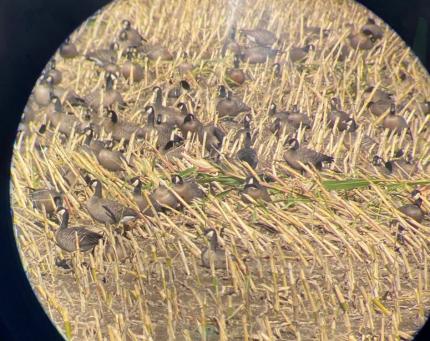
Columbian White-tailed Deer Surveys: Biologists Stephens and Holman along with Conflict Specialist Aubrey completed the annual surveys for Columbian white-tailed deer on Puget Island. Surveys consist of driving designated routes and counting all deer and classifying them as doe, fawn, or buck. The primary purpose of the survey is to generate a doe to fawn ratio and therefore monitor the annual productivity of the population. This survey is done in partnership with the U. S. Fish and Wildlife Service, the Cowlitz Tribe, Oregon Department of Fish and Wildlife, and with support from volunteers, all of whom survey different white-tail populations. Survey results will be summarized in future reports. Thanks to Customer Service Specialists Kean and Splitgerber as well as Regional Operations Manager Varley and Regional Director Sallee for participating in the surveys.

Collared Deer Mortality: On Christmas Eve morning Biologist Bergh received a message indicating that one of the GPS-collared mule deer in the Klickitat mule deer migration study had died. The collar had detected no movement for nine consecutive hours the day prior. When she arrived Bergh only found the collar and the cut off ears with ear tags attached. This was on private land in GMU 382 which was not currently open to tribal or non-tribal hunting.

Mudflow Elk Count: Assistant Manager Risley and Technician Crane had great visibility when they visited the Forest Learning Center where they conducted the bimonthly winter Mudflow elk count. Despite high snow levels, 108 individual elk were observed using Mudflow. Multiple visitors to the mountain stopped to talk during the survey. All were offered an opportunity to take a closer look using the spotting scope, which was then followed with additional questions about Mt. St. Helens’ most iconic and charismatic residents.
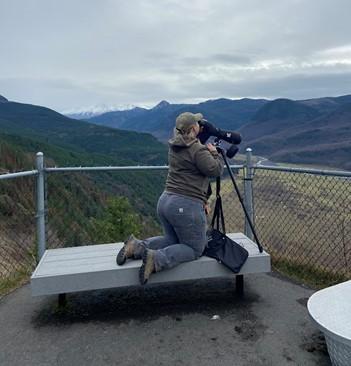

Injured Bald Eagle: Wildlife Conflict Specialist Jacobsen received a report of an injured bald eagle from Rowena Wildlife Clinic. A photographer was observing eagles along the mouth of the Klickitat River and saw one eagle that appeared to have an injured wing. When approached by the photographer, the eagle swam across the river to the cliffs on the other side. Jacobsen responded to the location and observed the injured eagle hopping on the cliffs across the river but was not able to access the bird’s location at the time. Later in the day, Biologist Wickhem was in the area and observed the eagle flying for a short distance. The eagle will likely recover on its own.

Injured Owl: Wildlife Conflict Specialist Jacobsen received a report of an injured great horned owl from Rowena Wildlife Clinic as well. A different photographer was observing owls in centeral Klickitat County and was concerned about an owl that appeared to have an eye injury. The photographer sent a video of the owl to Jacobsen. It is unclear what caused the injury to the eye, but Jacobsen determined that the owl was still very mobile and not a candidate for capture and treatment.

Deer Collar Retrieval: Wildlife Conflict Specialist Jacobsen and Volunteer Ridout collected a GPS collar which had reached the end of its lifespan and automatically fallen off a mule deer in Klickitat County. While driving in to collect the collar, Jacobsen and Volunteer Ridout observed two sets of fairly fresh cougar tracks in the snow.
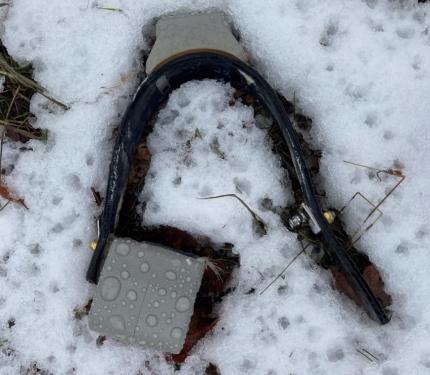

Providing Recreation Opportunities
Kress Lake Access Area: Access staff members have had to clean up multiple fallen trees over the last few weeks due to heavy wind and rains. Shown below is the 4th tree in the last month that has fallen at Kress Lake Access Area. Other sites have suffered the same but Kress Lake seems to be the hardest hit at this time. This type of clean up is a nice change of pace from the normal garbage dumps and other human caused abuse.
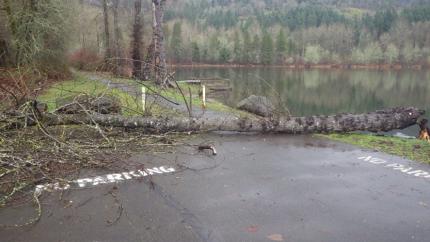
Providing Conflict Prevention and Education
Animal Tracks: A concerned homeowner contacted Washington Department of Fish and Wildlife staff members regarding some odd tracks and markings on a tree in her yard. Jacobsen provided advice to the reporting party and although he was not able to determine the identity of the track-maker. Jacobsen was able to rule out black bear, which was what the homeowner was concerned about.
Deer Fencing: Wildlife Conflict Specialist Jacobsen met with a Clark County landowner regarding ongoing deer rubbing damage to his Christmas tree operation. Jacobsen has been planning a deer fencing installation with the producer for this coming spring. Jacobsen walked the property with the landowner, identified new deer damage, and marked the boundaries for the proposed fencing project.

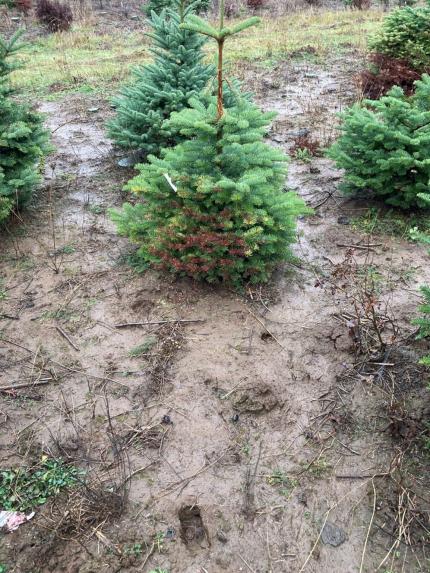
Depredation on Chicken: A landowner contacted Washington Department of Fish and Wildlife. They requested assistance preventing bobcat depredations on his chickens. Wildlife Conflict Specialist Jacobsen met with the landowner and inspected the landowner’s chicken coop. The landowner had one remaining chicken but planned to get more in the spring. Jacobsen provided advice on securing gaps in the existing chicken coop as well as utilizing an electric fence to prevent bobcats and other carnivores from accessing the chickens in their day pen. The landowner was appreciative of the assistance.

Cougar Samples: Officer Nelson responded to a report of a cougar that had killed a miniature pony. The landowner had shot and killed the cougar in the middle of the depredation. Jacobsen assisted Officer Nelson with pulling a tooth for aging purposes and pulling a tissue sample for genetic analysis (PDF). The cougar was a sub-adult male, as evidenced by the distinct black mark between the cougar’s legs (only males have this black penis sheath) and the residual spotting on the cougar’s hide, particularly on the insides of the limbs, known as “banding” at this stage in life.

Garbage-Habituated Black Bear: Wildlife Conflict Specialist Jacobsen received a report from a Clark County residence regarding a black bear that had been regularly accessing stored garbage. The garbage had been stored in a poorly secured shed and the bear had gotten into the garbage multiple times before the homeowner contacted Washington Department of Fish and Wildlife. Jacobsen advised the homeowner on how to erect electric fencing around a structure and coordinated with Officer Hughes to loan out an electric fence energizer to the homeowner. After erecting the fence, the bear ceased accessing the garbage.

Conserving Natural Landscapes
Seeding and Surveying at Eagle Island: Assistant Regional Program Manager Hauswald and Assistant Manager Risley paid a visit to the Eagle Island Unit of the Mt. St. Helens Wildlife Area to seed wildflowers and native grasses at multiple grassland areas on the 230-acre island. A generous donation of native pollinator seed mix was made available to the wildlife area courtesy of Cowlitz Noxious Weed Control and Washington State Noxious Weed Control Board. A labor of love and patience, the wildflowers are not likely to flower and set new seed for approximately two years, but wildlife area staff members hope that the native plants will eventually fill in the grassland areas where they’ve been introduced and, subsequently, naturally reseed adjacent areas.

Hauswald and Assistant Manager Risley spent the latter part of the day surveying the forested portions of the island for invasive holly and assessing the success of past treatments of Scotch broom and blackberry. It was a beautiful day on the island and many eagles, ducks, and signs of deer presence were observed.

Mowing at Shillapoo Wildlife Area: Assistant Manager Breitenstein and Technician Crane spent the last several weeks mowing at the Shillapoo Wildlife Area. Mowing is completed annually on the wildlife area and is used to maintain green forage availability for overwintering waterfowl, as well as control invasive species such as Himalayan blackberry, reed canary grass, and Canada thistle. Mowing must be timed correctly to be completed before the ground becomes too wet for equipment to drive over but start late enough to avoid destroying too much cover during the pheasant hunt.

